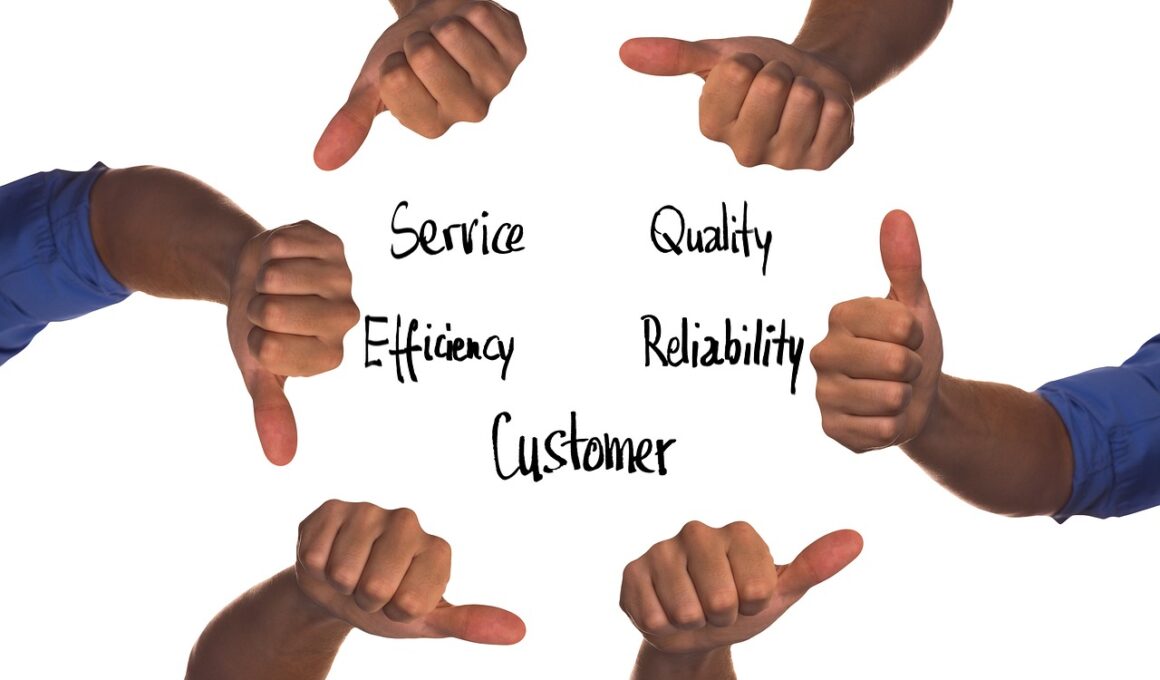The Impact of Customer Segmentation on Marketing Campaign Performance
Understanding customer segmentation is vital for tailoring marketing strategies that resonate with different audience groups. This approach allows businesses to divide their customers into distinct segments based on various factors such as demographics, purchasing behavior, and preferences. As a result, marketers can develop targeted campaigns that can significantly enhance engagement and return on investment (ROI). Customized marketing efforts, tailored to specific customer segments, contribute to increased customer loyalty and satisfaction. Furthermore, segmenting customers paves the way for personalized communication, which makes customers feel valued and understood. With modern analytics tools, businesses can gather and analyze vast amounts of customer data to refine their segmentation strategies continually. By leveraging insights from customer feedback analysis, marketers can adapt their campaigns dynamically, ensuring they remain relevant. Overall, customer segmentation fosters a deeper connection with the target audience, transforming generic marketing efforts into personalized experiences that drive results. The implementation of effective segmentation strategies leads to enhanced marketing campaign performance, ultimately influencing organizational success and profitability in a highly competitive landscape. Businesses that embrace this methodology are likely to achieve more effective outcomes in their marketing endeavors, making segmentation an essential strategy for growth.
In addition to enhancing marketing effectiveness, customer segmentation plays a crucial role in optimizing resource allocation. By understanding which segments yield the highest potential for revenue, companies can direct their resources effectively where they will have the most impact. This leads to better budgeting, ensuring that marketing efforts are concentrated on promising segments. Through this focus, companies can avoid wasting resources on less profitable demographic groups. This strategic allocation not only maximizes marketing outcomes but also enhances overall business efficiency. Moreover, segmentation can uncover niche markets that may have been previously overlooked. These markets often present unique opportunities for growth and sales, which can substantially contribute to profitability. Advanced customer feedback analysis tools can assist in identifying these niches by revealing unmet needs and preferences within segments. As companies gain a deeper understanding of their diverse customer profiles, they can craft unique selling propositions tailored to each segment. This strategy can create a competitive edge in the marketplace, promoting stronger brand loyalty and customer retention. In a world where customers are bombarded with general marketing messages, being targeted with personalized communication helps brands stand out and build lasting relationships with their customers.
Strategies for Effective Customer Segmentation
To implement effective customer segmentation, organizations should begin with comprehensive data collection. This can include demographic information, purchase history, and feedback gathered from various touchpoints. Analyzing this data helps identify patterns and traits that distinguish different customer segments. Once segments are identified, businesses can tailor their messaging and offerings to meet the unique needs of each group. For example, younger consumers may prefer more digital engagement channels, while older adults may respond better to traditional marketing approaches. Businesses should also consider behavior-based segmentation, where customers are grouped according to their interactions and purchasing patterns. This allows for highly targeted marketing strategies that consider how customers engage with the brand. Additionally, continual feedback analysis is vital to identify shifts in customer preferences and market trends. Regularly updating segmentation strategies based on this feedback ensures that marketing efforts remain aligned with customer desires. Businesses that utilize these strategies effectively can position themselves to respond proactively to changing market conditions and enhance their campaign performance significantly. In a rapidly evolving marketplace, staying ahead of the curve is essential for maintaining competitiveness and achieving long-term success.
Emphasizing data-driven decisions strengthens the foundations of customer segmentation. Companies can utilize various analytical tools that provide insights into customer behavior and preferences. This data informs strategic decisions regarding product development, pricing, and promotional strategies. The automation of data analysis allows for real-time adjustments to marketing campaigns, enhancing responsiveness to customer behavior changes. Furthermore, engaging with customers through surveys and questionnaires enriches feedback analysis, ensuring their voices shape segmentation practices. This customer-centric approach not only fosters trust but also nurtures brand loyalty, as consumers feel their needs are acknowledged. Maintaining a dynamic approach to segmentation is essential, as customer preferences evolve over time, influenced by changing market trends and economic conditions. Businesses that remain adaptable are better equipped to refine their offerings and marketing communications. It’s important to note that segmentation should not be seen as a one-time effort but rather an ongoing process that evolves alongside consumer behavior. Essentially, data-driven segmentation informs campaign performance significantly, enhancing overall effectiveness. Therefore, by continually investing in understanding their customers deeply, businesses can drive better engagement and ultimately achieve higher marketing outcomes through tailored campaign strategies.
The Role of Technology in Customer Segmentation
Technology plays an indispensable role in advancing customer segmentation practices. With the rise of artificial intelligence and machine learning, businesses can now analyze customer data on a scale previously thought impossible. These technologies identify subtle patterns that traditional analysis might overlook, unveiling complex consumer preferences and behaviors. Utilizing predictive analytics, companies can forecast trends and adjust their marketing strategies to capture emerging opportunities. The integration of CRM systems further enhances customer segmentation by centralizing data and allowing for seamless tracking of customer interactions across various channels. By leveraging technology, businesses not only enhance their capability to conduct comprehensive segmentation but also improve the accuracy of their marketing efforts. Automation tools also allow for efficient management of multi-channel campaigns, ensuring consistent messaging that resonates with different segments. Moreover, engaging customers through digital platforms amplifies the data collected, enriching segmentation efforts further. Marketers can use this data to implement A/B testing approaches, honing their messaging to achieve the strongest performance. In today’s technology-driven landscape, utilizing the right tools for customer segmentation not only streamlines processes but also fosters innovative marketing strategies that propel businesses forward.
Ultimately, measuring the impact of customer segmentation on marketing success is crucial for continuous improvement. Key performance indicators (KPIs) such as open rates, conversion rates, and return on ad spend can reveal the effectiveness of targeted campaigns. Businesses need to analyze these metrics regularly to understand which segments respond best to specific marketing strategies. This ongoing analysis allows marketers to iterate on their campaigns quickly, adapting to feedback and performance data effectively. By doing so, they can refine their efforts and allocate resources to strategies that yield the highest ROI. Additionally, testimonials and case studies can provide qualitative insights into how segmentation positively influences customer experiences. As businesses gather more data over time, they can develop increasingly accurate segmentation profiles that guide marketing decisions. Companies should also invest in advanced reporting tools that facilitate real-time analysis, providing insights that inform immediate strategy adjustments. Continuous testing and learning improve overall marketing effectiveness and help identify future opportunities for growth. As segmentation strategies become more sophisticated, businesses enhance their capability to deliver exceptional marketing campaigns tailored to the evolving needs of their diverse customer base.
Conclusion and Future Directions
In conclusion, customer segmentation profoundly influences marketing campaign performance, offering businesses a powerful framework to optimize their strategies. The ability to understand and cater to diverse customer preferences allows for personalized marketing approaches that resonate effectively with target audiences. As technology continues to evolve, further advancements will streamline segmentation practices, enabling even more precise targeting. Companies that embrace innovative tools and data-driven strategies will be better positioned to thrive in competitive markets. As consumer behavior becomes increasingly complex, the quest for deeper insights will require continuous adaptation and learning. This proactive approach to segmentation will facilitate lasting customer relationships and bolster brand loyalty. Future research should explore the intersection of customer segmentation with emerging technologies like big data analytics and social media insights. Businesses that prioritize customer engagement through targeted efforts will not only improve campaign performance but also enhance customer experiences significantly. As marketing landscapes evolve, organizations must remain committed to developing precise segmentation strategies that align with consumer desires. Ultimately, by harnessing the potential of effective customer segmentation, businesses can ensure sustained growth and success in a dynamic marketplace.
As businesses look to the future, the focus on customer segmentation will only intensify. Innovative technologies and methodologies will continue to emerge, reshaping how companies view their customer bases. By leveraging data, creativity, and technology, organizations are poised to craft even more personalized marketing strategies that resonate with individual consumers. This focus not only enhances marketing campaign performance but also fosters deeper connections between brands and their customers. As customer values and preferences shift, companies must stay attuned to these changes, evolving their segmentation strategies accordingly. This adaptability will be critical, as market dynamics become increasingly unpredictable. Additionally, the potential for multi-channel engagement creates a sprawling canvas for marketers to explore. Aligning strategies across various platforms ensures that messages remain consistent and engaging, enhancing the overall customer experience. Businesses should prioritize agility in their approach to segmentation, allowing them to pivot quickly in response to feedback and data insights. In conclusion, by committing to a robust understanding of customer segmentation, businesses can unlock the full potential of their marketing campaigns, driving higher engagement and establishing stronger relationships with their clients.


